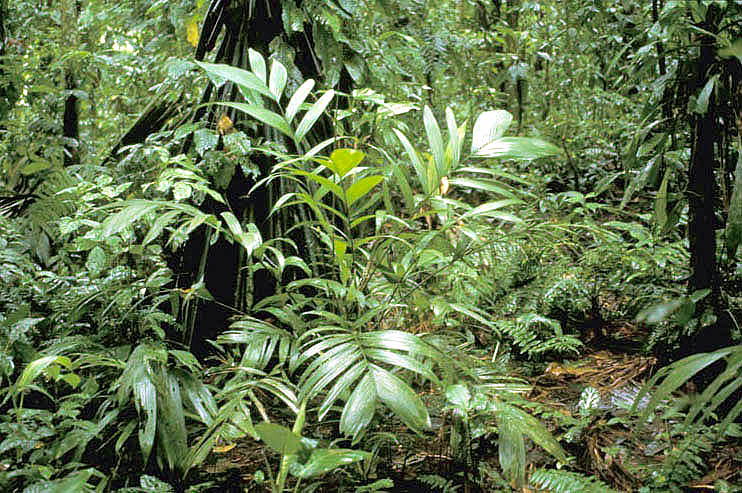Attalea colenda
(O.F.Cook) Balslev & A.J.Hend.
Original
reference:
Brittonia 39: 1 (1987)
Basionym:
Ynesa colenda O.F.Cook
Morphology:
Canopy palm. Stem solitary, to 35 m tall and 35-60 cm in diameter, smooth, with neatly abscising leaves. Leaves arching, with twisted leaf axis so that the distal part of the blade stands in a vertical plane; pinnae to 200 on each side, regularly inserted in one plane, the central ones 150-200 cm long and 6-9 cm wide, with cross veins inconspicuous. Inflorescence erect, 150-300 cm long; branches 600-800, to 40 cm long. Male flowers pale yellow, with triangular, imbricate petals, 10-12 mm long, and 8-11 stamens of the same length. Female flowers 10-15 mm long. Fruits light brown to orange at maturity, 4-6 cm long, with 1-3 seeds.
Distribution:
DW Ecuador and adjacent parts of Colombia (Nariño), in somewhat seasonal, moist forest, often left in cleared areas.
Conservation
status: Vulnerable
–
IUCN criteria:
A1c, B1, B2c
(Borchsenius & Skov 1999)
Common
names:
Chivila
–
Spanish
(F. Skov #64828).
Palma real
–
Spanish
(H. Balslev #62027 and additional references).
ya´- tcî
–
Chachi
(Barrett 1925).
Uses:
In Manta oil from the seeds is extracted commercially, and used for cooking oil
(Blicher-Mathiesen & Balslev 1990 and additional references).
Leaf base fibres are used for burden-bands and as strings on harps
(Barrett 1925).
The mesocarp and the endosperm are edible
(Blicher-Mathiesen & Balslev 1990 and additional references).
The palm begins to produce fruits after 10-12 years. It produces 1-2 infructescescences per year. Each infructescence weighs between 150 and 600 kg; it contains 2100-7000 fruits. The dry weight of seeds corresponds to 60-150 pounds per infructescence. The palm lives and produces fruits for more than a century. In 1971 the value of 500 pounds of peeled seeds was 80,000-90,000 sucres
(Acosta-Solís 1971).
The palm heart is edible, raw or boiled.
(Barrett 1925).
|
Latest posts by admin (see all)
- Aluminium Rattan Garden Furniture Design Ideas - September 11, 2019
- Popular Gardens and Parks in Sheffield, United Kingdom - September 18, 2018
- How New Eco-Friendly Garden Benches Help Plants and Consumers in the UK - February 26, 2018




Discussion: